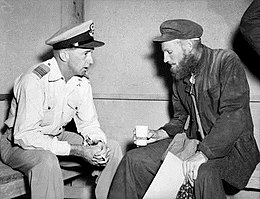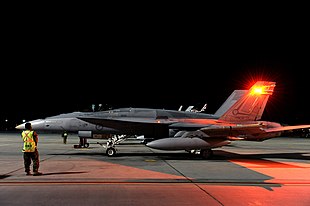Neville McNamara
Sir Neville McNamara | |
|---|---|
Born in
Early life and World War II
Neville Patrick McNamara was born on 17 April 1923 in
Post-war career
Rise to senior command
After the war, McNamara was stationed in Japan with

Returning to Australia in 1954, McNamara was posted to
In 1960, McNamara was posted to the UK to attend the
Senior RAAF and Defence Force command
Promoted to acting

McNamara was promoted to
In 1982, McNamara became the first Air Force member to directly command all three of Australia's armed services as Chief of the Defence Force Staff (CDFS), which had replaced the earlier senior position in the defence force, Chairman of the Chiefs of Staff Committee. He also became only the second RAAF officer to be raised to the rank of air chief marshal.[1][2] As CDFS, McNamara had to work to repair strained relations between the Defence Department's military and civilian components. He sought to accomplish this through a restrained management style and respect for the department's public servants. At the same time, he maintained the need for military and civilian personnel to be easily distinguishable, and reversed a trend for armed force personnel to wear suits "in the office" and uniforms only "on parade", which was the preference of Secretary of the Department of Defence Arthur Tange.[3][32] The military and public service wings of the department still clashed over the question of enlarging the CDFS's role to achieve more coherent defence planning.[33] Shortly after McNamara completed his term as CDFS in 1984, the position was redesignated Chief of the Defence Force (CDF), to more clearly reflect its authority over the Australian armed services.[1][34]
Retirement
Air Chief Marshal McNamara retired from military life in April 1984. He was awarded the
Notes
- ^ a b c d Clark, Dr Chris (19 May 2005). "Air Force Defence Chiefs of the Past". Air Force News, Volume 47, No. 8. Archived from the original on 8 June 2011. Retrieved 10 May 2014. The first four-star RAAF officer was Air Chief Marshal Sir Frederick Scherger, who served as Chairman of the Chiefs of Staff Committee from 1961 to 1966.
- ^ a b c d e f g h Dennis et al., Oxford Companion to Australian Military History, pp. 338–339
- ^ a b c d e f g h i j Stephens; Isaacs, High Fliers, pp. 162–164
- ^ "Royal Australian Air Force – Citizen Air Force". Commonwealth of Australia Gazette. No. 145. 20 July 1944. pp. 1483–1484. Retrieved 11 January 2019.
- ^ "Royal Australian Air Force – Citizen Air Force". Commonwealth of Australia Gazette. No. 252. 20 December 1944. p. 2833. Retrieved 11 January 2019.
- ^ a b c d e f "Air Chief Marshals". Air Marshals of the RAAF. Royal Australian Air Force Air Power Development Centre. Archived from the original on 25 May 2013. Retrieved 14 July 2010.
- ^ "Royal Australian Air Force – Citizen Air Force". Commonwealth of Australia Gazette. No. 129. 18 July 1946. p. 1984. Retrieved 11 January 2019.
- ^ "Royal Australian Air Force – Permanent Air Force". Commonwealth of Australia Gazette. No. 139. 23 September 1948. p. 3388. Retrieved 11 January 2019.
- ^ a b c d e Singh, Who's Who in Australia 2010, p. 1412
- ^ "Royal Australian Air Force – Permanent Air Force". Commonwealth of Australia Gazette. No. 23. 5 April 1951. p. 856. Retrieved 11 January 2019.
- ^ "Royal Australian Air Force – Permanent Air Force". Commonwealth of Australia Gazette. No. 49. 10 July 1952. p. 3067. Retrieved 11 January 2019.
- ^ Stephens, The Royal Australian Air Force, pp. 238–240
- ^ O'Neill, Australia in the Korean War, p. 591
- ^ "Royal Australian Air Force – Permanent Air Force". Commonwealth of Australia Gazette. No. 38. 4 July 1957. p. 2032. Retrieved 11 January 2019.
- ^ Stephens, Going Solo, pp. 167–168
- ^ "No. 42371". The London Gazette (Supplement). 10 June 1961. p. 4182.
- ^ Stephens, The Royal Australian Air Force, pp. 254–257
- ^ "Royal Australian Air Force – Permanent Air Force". Commonwealth of Australia Gazette. No. 54. 22 June 1967. p. 3270. Retrieved 11 January 2019.
- ^ "Royal Australian Air Force – Permanent Air Force". Commonwealth of Australia Gazette. No. 93. 26 October 1967. p. 5875. Retrieved 11 January 2019.
- ^ "Royal Australian Air Force – Permanent Air Force". Commonwealth of Australia Gazette. No. 29. 18 March 1971. p. 1904. Retrieved 11 January 2019.
- ^ Coulthard-Clark, The RAAF in Vietnam, p. 339
- ^ Stephens, Going Solo, p. 290
- ^ "No. 45767". The London Gazette (Supplement). 1 September 1972. p. 10457.
- ^ "Royal Australian Air Force – Permanent Air Force". Commonwealth of Australia Gazette. No. 120. 22 December 1971. p. 7739. Retrieved 11 January 2019.
- ^ "Royal Australian Air Force – Permanent Air Force". Australian Government Gazette. No. G3. 21 January 1975. p. 83. Retrieved 11 January 2019.
- ^ "Officer of the Order of Australia". It's an Honour. Archived from the original on 1 August 2017. Retrieved 10 May 2014.
- ^ Stephens, Going Solo, p. 80
- ^ Stephens, The Royal Australian Air Force, pp. 296–297
- ^ Cox; Gray, Air Power History, p. 238
- ^ Stephens, Power Plus Attitude, p. 177
- ^ "No. 48468". The London Gazette (Supplement). 31 December 1980. p. 36.
- ^ Andrews, The Department of Defence, pp. 230–231
- ^ Andrews, The Department of Defence, pp. 244–245
- ^ Horner, David (2002). "The Evolution of Australian Higher Command Arrangements". Command Papers. Canberra: Centre for Defence Leadership Studies, Australian Defence College: 25. Archived from the original on 9 November 2014.
- ^ "Centenary Medal". It's an Honour. Archived from the original on 2 August 2017. Retrieved 10 May 2014.
- ^ Cardillo, Teena (May 2001). "RAAF 80th Anniversary: Point Cook Celebrates in Style". Air Force News. Archived from the original on 29 May 2010. Retrieved 10 May 2014.
- ^ "The Quiet Man". Air Power Development Centre. Retrieved 10 May 2014.
- ^ "Sir Neville McNamara – obituary". The West Australian. 10 May 2014. Archived from the original on 10 May 2014. Retrieved 10 May 2014.
- ^ "Sir Neville McNamara Drive". Whereis. Retrieved 10 May 2014.
References
- ISBN 0-19-554113-8.
- Coulthard-Clark, Chris (1995). The RAAF in Vietnam: Australian Air Involvement in the Vietnam War 1962–1975. St Leonards, New South Wales: ISBN 1-86373-305-1.
- Cox, Sebastian; Gray, Peter (2008). Air Power History: Turning Points from Kitty Hawk to Kosovo. London: Frank Cass. ISBN 978-0-7146-8257-0.
- Dennis, Peter; ISBN 978-0-19-551784-2.
- OCLC 478961785.
- Singh, Shivani (2010). ISBN 978-1-74095-172-2.
- Stephens, Alan (1995). Going Solo: The Royal Australian Air Force 1946–1971. Canberra: Australian Government Publishing Service. ISBN 0-644-42803-1.
- Stephens, Alan (1992). Power Plus Attitude: Ideas, Strategy and Doctrine in the Royal Australian Air Force 1921–1991. Canberra: Australian Government Publishing Service. ISBN 0-644-24388-0.
- Stephens, Alan (2006) [2001]. The Royal Australian Air Force: A History. London: Oxford University Press. ISBN 0-19-555541-4.
- Stephens, Alan; Isaacs, Jeff (1996). High Fliers: Leaders of the Royal Australian Air Force. Canberra: Australian Government Publishing Service. ISBN 0-644-45682-5.
Further reading
- McNamara, Neville (2005). The Quiet Man: The Autobiography of Air Chief Marshal Sir Neville McNamara. Tuggeranong, Australian Capital Territory: Air Power Development Centre. ISBN 1-920800-07-7

